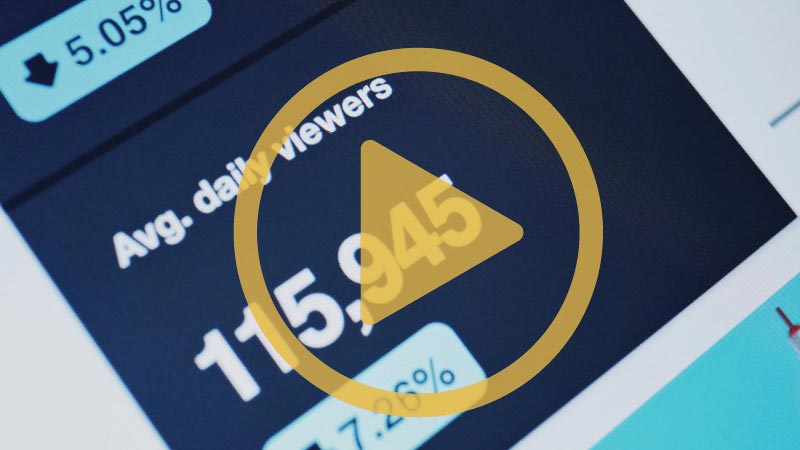Who doesn’t love a good story? People love stories, especially ones that are engaging, relatable and evoke a strong emotional response. Whether it’s telling ghost stories gathered around a campfire or launching a content marketing initiative, the goal is always the same: To grab your audience’s attention. Effective storytelling is a key ingredient.
I’ve been a professional storyteller for 30 years, and these are some of my favorite effective storytelling tricks and tips that could help you stand out from the pack.
1. Know Your Audience
Your copy should meet the needs of a specific audience. Who do you want to reach? That’s where doing your due diligence is important. Through research (perhaps with the help of your strategy team) you can fine-tune your messaging so it’s not speaking to an audience that’s not interested in what you’re trying to sell.
For instance, say you’re working for a marketing agency representing a food industry business. A headline such as “healthy groceries with simple recipes” is targeting an audience that’s A) health-conscious about their food and B) doesn’t want to spend an hour in the kitchen (more about writing good headlines below). Aligning your messaging around your audience’s wants and needs can make your content more appetizing. Bonus points if the business’s stakeholders can share detailed demographic information about their target audience.
2. Focus on Your Unique Value
Known as the value proposition, your content should try to answer this key question: What makes the product or service uniquely valuable for your audience? This goes beyond explaining the value. It’s describing what makes it special. Why is this better or different than the competition?
One example is a company that found success by selling polarized sunglasses that include protection in case you lose or break a pair. Most polarized sunglasses are a bit pricey, and many don’t have lost or broken protection. So informing consumers about the difference was a crucial part of the brand’s storytelling.
Another example is communicating with your audience based on common personality traits. One marketing expert, for example, posted an attention-grabbing “dear perfectionists” note on her LinkedIn page, knowing that would resonate with part of her audience. Sure enough, the post received thousands of views and more than 100 comments.
3. Craft Captivating Headlines
Grabbing your audience’s attention depends a lot on your headline. A well-crafted, irresistible headline can prompt readers to click to read more. A few tricks of the trade include:
- Focusing on clarity versus wit: Witty copy can confuse your audience, especially absent of visual cues.
- Using odd numbers: This helps people digest and recall information more easily. Studies also show this will increase your click-through rate.
- Including keywords your audience is searching for: Just make sure to keep it natural versus forced.
- Finding a unique hook: Also, referred to as the “angle” or point of view of your content. Choose a hook that piques your audience’s curiosity.
- Making it specific and easy to remember: Think Geico’s “15 minutes can save you …” slogan.
- Addressing a problem or dilemma your content can help solve: Your business is here to provide a solution (or several) to your target audience, and so should your content. Make sure that’s clear from the get-go.
- Using strong words that get higher click-throughs: For instance, words such as smart, surprising, science, history, critical and powerful.
- Trying out some of these phrases: According to Oncrawl, an SEO and data platform, the following phrases perform well with blog posts:
- The secret to …
- How to (specific task) that (rewarding benefit)
- How to (desired result) without (painful objection)
- (Do something) like (world-class example)
- What you need to know about …
When thinking about headlines, legendary copywriter Eugene Schwartz summed it up best in his book Breakthrough Advertising. He wrote: “Copy cannot create desire for a product. It can only take the hopes, dreams, fears and desires that already exist in the hearts of millions of people, and focus those already-existing desires onto a particular product. This is the copywriter’s task: not to create this mass desire—but to channel and direct it.”
4. Use These Online Writing Tools to Improve Your Content
Sometimes finding the right turn of phrase can be a challenge, so having a thesaurus, or several, can come in handy. A few worth bookmarking include:
- Power Thesaurus, a community-driven tool with results vetted and ranked by site visitors.
- Phrase Thesaurus, which generates phrases based on the words you enter.
- Word Hippo, which matches short phrases (good if you’re trying to find a better way of saying something that might be a cliché).
Other writing tools to consider:
- Grammarly, a tool that checks for spelling but also flags issues involving grammar, punctuation, clarity and overuse of a word or phrase.
- Hemingway Editor, which highlights common errors and recommends ways to tighten up your writing so your content is clear and concise. It’s no coincidence the tool’s namesake is also famous for using natural, easy-to-read language.
5. Avoid Mistakes
This tip is quite obvious, but nevertheless important. Errors can create an impression of carelessness, damaging your credibility as a result.
Wondering if it’s every day or everyday? Capitol or capital? Comprise or compose? My friend and colleague Karen Sommerfeld wrote a four-part series on avoiding common grammar and spelling mistakes. Check it out:
6. Read It Out Loud
Probably one of the easiest things you can do to help ensure your copy is spot on is reading it out loud. Do certain phrases or sentences sound a bit off? Chances are your audience will find reading it awkward as well.
It’s also a great way to catch errors you might have missed. This of course is easier to do if you’re alone, such as working from home. If you’re in the office surrounded by co-workers, see if there’s a quiet area or empty office you can borrow for a few minutes (or if the weather’s nice, step outside).
7. Have a Close Friend or Loved One Read It
Finding someone who isn’t closely tied to what you’re writing can provide some fresh perspective—along with some constructive criticism since they’re looking out for your best interests. Some of my best friends can be brutally honest at times, but that’s OK. That’s what friends are for—to keep us humble.
TL;DR
People love stories. So, if you want to grab your audience’s attention, why not use storytelling?
To truly capture the hearts and minds of your audience, though, you’ll have to take your storytelling to the next level. Here are seven tips inspired by my 30 years of experience to help you develop effective storytelling content that moves your audience to action:
- Know Your Audience: Research your target audience and understand their specific needs. Your copy should directly align with and address their needs.
- Focus On Your Unique Value: Make your value proposition clear and known upfront while also going the extra mile and showcasing what makes you unique.
- Craft Captivating Headlines: A catchy headline can pull your audience in and elicit them to click and read more. At the very least, ensure your headlines use keywords, address the problem you’re solving, and are clear and concise.
- Use These Online Writing Tools to Improve Your Content: Take advantage of technology and get a little boost!
- Avoid Mistakes: Though obvious, make sure your copy is error-free because mistakes can harm your credibility.
- Read It Out Loud: Whether working from home or in the office, find the time and place to read your content out loud—it makes all the difference.
- Have a Close Friend or Loved One Read It: They have your best interests at heart and their perspectives can provide a refreshing—and unfiltered—take on your content.



